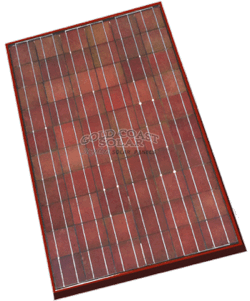Ventura Firm Brings Color To Photovoltaic Panels

Photovoltaic (PV) panels in urban settings are very likely the future of solar electricity, as they're cheaper, more reliable, and simpler to operate than their solar thermal counterparts, and offer the possibility of a more decentralized, sturdier grid. But there's one thing even the most ardent advocate of PV panels has to admit: the things aren't pretty.They're conspicuous. They don't blend in to their surroundings. As Henry Ford might have said about them, you can get any color of PV panel you want as long as it's an unearthly blue-black. It may seem a superficial point. Still, design rules our lives, and in order for a technology to gain wide acceptance it generally has to be able to blend seamlessly into our existing lives.
A California developer's PV panels might be able to do just that.
Gold Coast Solar, a Ventura firm, has just gained both Underwriters' Laboratories and ETL safety certification for its line of colored photovoltaic panels, the first manufacturer of colored PV panels to do so. The company claims that National Renewable Energy Laboratory tests show its panels produce power every bit as efficiently as their bog-standard off-black counterparts. Using the same polycrystalline silicon wafers as other high-end PV panels, Gold Coast Solar tints them in a proprietary process to produce four colors of the firm's trademarked "Stylish Solar Panels," including terra cotta and verdigris models.
It's an interesting approach to a problem that increasingly faces urban PV. It's difficult to suggest installing standard PV on historic and architecturally sensitive structures, as the obtrusive character of the panels can radically alter a building's appearance. And while California's Solar Rights Act of 1978 technically bars homeowners associations (HOAs) from interfering with individual installations of solar panels, the part of that law that reads "This section does not apply to provisions that impose reasonable restrictions on solar energy systems" has facilitated three decades of HOA opposition to even fairly modest PV installations.
If PV panels weren't so obtrusive -- if they could blend in with tile or verdigris roofs or marble walls -- they'd certainly be easier to incorporate into architecturally protected settings. They might even get past an HOA board here and there. The test of any construction material is in years of standard use, and it's too early to tell whether Gold Coast Solar's products will fade in color, lose efficiency, or otherwise fail to perform as hoped after 10 or 15 years.
But they definitely have a good idea.
ReWire is dedicated to covering renewable energy in California. Keep in touch by liking us on Facebook, and help shape our editorial direction by taking this quick survey here.


